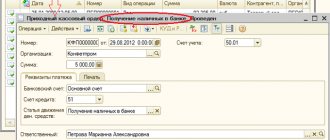Cash transactions are widely used in trade organizations, as well as in enterprises that make payments to employees through the cash register. To record these transactions, accounting account 50 is used. In the article we will talk about the main aspects of using the account, and also consider typical transactions and examples of cash transactions.
Accounting for cash on account 50 – “Cash desk”
Accounting account 50 is intended for accounting for cash flows, that is, for accounting for cash transactions. Debit 50 is intended to reflect cash inflows, credit 50 is intended to reflect cash outflows.
Documentation of cash transactions
All cash receipts and payments must be reflected in the statutory cash book; its maintenance is mandatory for every organization. All entries in the cash book are made on the basis of primary documents: incoming and outgoing cash orders. The entry of cash into the cash register is formalized by a cash receipt order, unified form KO-1, and the write-off of cash from the cash register is formalized by an expenditure cash order, form KO-2.
Analysis of account 50 shows that account 50 is active, intended to reflect assets (cash), its balance is always debit. An increase in an asset is reflected in a debit, a decrease in a credit.
Transactions with cash necessarily involve the use of cash registers, with the exception of some types of activities for which strict reporting forms can be used; read more about this in this article.
For each organization, a cash balance limit is established, that is, the amount of cash that can remain in the cash register at the end of the day; the amount in excess of the limit must be handed over to the bank at the end of each working day. When transferring cash to the bank, a forwarding slip is issued for the bag. The excess amount of cash can be left only to pay wages and benefits, but no more than five working days, including the day the bank issues the money.
The cash desk can store not only cash, but also monetary documents (paid tickets, vouchers).
Conducting cash transactions is regulated by certain regulatory documents that must be studied for proper cash accounting and proper cash management.
Regulatory documents for cash transactions: (click to expand)
- The Regulation “On the procedure for conducting cash transactions with banknotes and coins of the Bank of Russia on the territory of the Russian Federation”, approved by the Bank of Russia on October 12, 2011 No. 373P, is the main document regulating cash transactions.
- Regulations on the use of KKM No. 745 1993 (ed. 08.08.2003)
- Directive of the Bank of Russia dated June 20, 2007 No. 1843-U “On the maximum amount of cash settlements between legal entities.” At the moment, the maximum amount of cash payments between legal entities is limited to 100 thousand rubles.
| ★ Best-selling book “Accounting from scratch” for dummies (understand how to do accounting in 72 hours) > 8000 books purchased |
Cash desk of economic entities
If an enterprise works with cash (receives sums of money from customers, issues them for reporting, receives them from a bank account, issues and accepts cash documents), then its responsibilities include conducting cash transactions. At the same time, cash discipline must be observed in terms of processing transactions, the procedure for issuing and receiving funds, and establishing an acceptable cash limit.
For more complete information, see the article “Cash discipline and responsibility for its violation.”
If the enterprise has the status of a small one or the business is registered as an individual entrepreneur, then cash discipline for such entities is less strict. For example, it is not necessary to approve a cash limit for them, as evidenced by the provisions of clause 2 of the Bank of Russia Directive No. 3210-U dated March 11, 2014.
For detailed information on the management of cash transactions by entrepreneurs, see the article “What are the features of cash discipline for individual entrepreneurs?”
Postings to account 50
| Debit | Credit | Operation name |
| 50 | 51 | Withdrawing money from a current account |
| 50 | 62 | Receiving payment from the buyer in cash to the cash register |
| 50 | 75 | Contribution to the authorized capital by the founder in cash |
| 60 | 50 | Payment to the supplier in cash |
| 70 | 50 | Payment of wages to employees |
The indicated accounting entries for accounting for cash transactions are the most common standard options; you will find a complete list of entries in the Chart of Accounts ().
Postings for cash withdrawal from the cash register
To meet the current needs of the organization, it is possible to use the cash available in the cash register. The list of expenses that can be made using amounts received as payment for goods and services of the company is reflected in clause 2 of the Bank of Russia Directive No. 3073-U dated October 7, 2013. These include, in particular:
- Salary, social benefits: Dt 70, 69 Kt 50.
- Payment for goods, works, services. At the same time, cash payments between legal entities and individual entrepreneurs are allowed if the amount of cash payments under the agreement does not exceed 100,000 rubles. (clause 6 of instruction No. 3073-U): Dt 60 Kt 50.
- Issuance of accountable amounts to employees to make current payments to the organization and pay for necessary services and materials: Dt 71 Kt 50.
- Refund of funds for failed transactions, if preliminary payment was made earlier in cash: Dt 62 Kt 50.
Payment of accrued dividends to the founders directly from the proceeds received at the cash desk is unacceptable. The exception is amounts received at the cash desk in other ways: withdrawal of cash from a current account for these purposes, return of imputed amounts. If the organization is a joint-stock company, then payment of dividends is possible only by transferring non-cash funds in accordance with clause 8 of Art. 42 Federal Law “On Joint Stock Companies” dated December 26, 1995 No. 208-FZ
It is also prohibited to use the proceeds received at the cash register for the subsequent issuance of loans or payment of rental payments for real and movable property.
Accounting for non-cash funds to account 51 – “Current account”
All non-cash payments can be made if you have a current account. It opens in a credit institution, otherwise called a bank. How to open a current account and what documents you need to provide, read this article.
To record the movement of non-cash funds of the organization, 51 accounting accounts are intended.
Is he active or passive?
Analysis of account 51 proves that it is active, it keeps records of the company's assets (non-cash money), and it always has a debit balance. The debit of account 51 is intended to reflect the receipt of non-cash funds (an increase in an asset), and the credit of account 51 is intended to reflect the write-off of non-cash funds (a decrease in an asset).
Currently, an organization is allowed to have several current accounts. Accounting account 51 () can be divided into several analytical ones, each of which will keep records for each individual current account of the enterprise.
The primary document confirming the fact of debiting and receiving non-cash funds is a bank statement, which contains information about all amounts received and debited from the organization’s current account.
Funds are written off on the basis of a payment order, which is drawn up in 2 copies and sent to the bank; one copy is marked by the bank stating that the order has been accepted and returned. When you deposit money from the cash register to your current account, an announcement is issued for a cash contribution.
Working with CCP (cash register equipment)
Many entities are required to use cash register systems in their activities due to legal requirements. These include enterprises that accept cash as payment from the public or contractors. Cash transactions in such cases are also subject to mandatory documentation.
All funds received via cash register are transferred to the organization’s main cash desk, as a rule, at the end of the shift (working day). Revenue can be transferred using PKO, or directly credited to the cash register.
If the institution provides a separate position for a cashier-operator, then the delivery of cash is accompanied by filling out a certificate-report in form No. KM-6, which contains information about the readings of cash register counters and the amount of cash received. In small organizations, this form is replaced by filling out a log for each cash register machine that records meter readings and cash flows.
Some categories of taxpayers are allowed not to use cash register systems when making cash payments. In such cases, they should be ready to issue strict reporting forms upon payment or provide, upon request, issued sales receipts confirming the fact of purchase. Subjects that may not use CCP include:
- Organizations and individual entrepreneurs on UTII or on the patent taxation system.
- Entities engaged in certain activities, the list of which is approved by law. This includes trading in kiosks, small retail peddling, sale of lottery tickets, securities, sale of religious products and other work.
- Institutions located in hard-to-reach and remote areas.
- Pharmacy organizations in rural areas.
Despite the fact that the use of cash registers for the listed entities is not a prerequisite, they still need to comply with other cash discipline.
Typical transactions for account 51
| Debit | Credit | Operation name |
| 51 | 62 | Receipt of payment or advance from the buyer |
| 51 | 50 | Cash deposit to the bank from the company's cash desk |
| <51 | 75 | Contribution to the Authorized Capital by non-cash means |
| 51 | 66 (67) | Obtaining a short-term (long-term) loan |
| 60 | 51 | Payment to the supplier by bank transfer |
| 50 | 51 | Withdrawing money from an account |
| 75 | 51 | Payment of dividends by bank transfer |
| 66 (67) | 51 | Repayment of credit (loan) |
Summarize:
An organization can use both cash and non-cash money for mutual settlements. To account for the former, a cash register is used, and for the latter, a current account is used. Each cash accounting operation must be documented in primary documents, and the corresponding entry is reflected in the accounting records.
Analytics and subaccounts
Analytical accounting for account 50 is carried out in the context of additionally opened sub-accounts:
- 50.1 “Cash of the organization” - used when accounting for the movement of cash resources in the cash desk of the enterprise;
- 50.2 “Operating cash desk” – used to account for funds in operating cash desks;
- 50.3 “Cash documents” – reflects the value of documents stored at the cash desk. These could be tickets, stamps, etc.
The number and composition of subaccounts may change based on the specifics of the organization’s accounting policies.
Example for wiring Dt 60 Kt 76
Let's look at one more situation.
Example 3
Let's take the conditions from example 2, but agree that the goods from the supplier were not received in full. When accepting the goods, LLC "Mag" revealed a shortage in the amount of 24,000 rubles. (including VAT 4,000 rubles) and filed a claim with the supplier.
Dt 60 Kt 76 - a claim was made for a shortage of goods of 24,000 rubles.
Dt 41 Kt 60 - the cost of the accepted goods is reflected as 101,000 rubles.
Dt 19 Kt 60 - reflected input VAT of 16,833.33 rubles.
Dt 51 Kt 76 - a refund was received from the supplier for undelivered goods in the amount of 24,000 rubles.
For information on the procedure for generating a balance sheet for account 60, see the article “Features of the balance sheet for account 60.”
In correspondence with which accounts are debit 60 and credit 60 applicable?
In accordance with the chart of accounts. 60 is active-passive, so both its debits and its credits can be used for accounting entries. The debit of this account is often used in correspondence with accounts: 50 “Cash”, 51 “Settlement accounts”, 52 “Currency accounts”, 55 “Special accounts in banks”, 62 “Settlements with buyers and customers”, 76 “Settlements with various debtors and creditors" and so on. (according to the instructions for the chart of accounts).
Credit account 60 is often paired with the following accounts: 08 “Investment in non-current assets”, 10 “Materials”, 15 “Procurement and acquisition of materials”, 20 “Main production”, 25 “General production expenses”, 26 “General expenses”, 41 “ Products" and so on.
In addition, for account 60 it is also possible to post Dt 60 Kt 60, the use of which is due to the reflection of transactions using different sub-accounts opened for account 60.
How is ledger account 60 used?
In accordance with the order of the Ministry of Finance of the Russian Federation “On approval of the Chart of Accounts” dated October 31, 2000 No. 94n (hereinafter referred to as the chart of accounts) account. 60 “Settlements with suppliers and contractors” is used to record transactions for the following business relationships with suppliers:
- acquisition of inventory items;
- acceptance of completed work;
- consumption of services provided;
- uninvoiced deliveries.
- other operations that are reflected in account 60 and provided for by the chart of accounts.
At the same time, for detail and correct reflection of information on transactions, sub-accounts to account 60 are used. An important point when opening sub-accounts is the need to secure them in the company’s working chart of accounts, which is approved by the accounting policy.
For recommendations on drawing up a working chart of accounts, see the material “Working Chart of Accounts - Sample 2017”.
Let's look at examples of possible subaccounts to account 60:
- 60.01 - settlements with suppliers and contractors;
- 60.02 - settlements for advances issued;
- 60.03 - settlements on bills issued;
- 60.04 - settlements for uninvoiced deliveries.
It is also possible to open other sub-accounts regulated by the company’s working chart of accounts.
Inventory of the cash register in the organization
Considering that the cashier or other person responsible for maintaining the cash register is financially responsible, they periodically conduct an inventory of the cash register. Actions are relevant when changing officials, reorganizing an entity, preparing financial statements, as a result of natural disasters or establishing facts of theft. Read the detailed article ⇒ “How the cash register inventory is carried out”
For these purposes, an inventory commission is created. During the process, the presence of a financially responsible person is required. Acts confirming actions (inventory lists) can be developed independently. At the same time, balances on monetary documents are also reconciled.
If a surplus or shortage is identified, you must obtain a written explanation from the cashier. All missing amounts are repaid at the expense of the responsible persons if there is a previously concluded agreement on liability with them. If the perpetrators are not identified (theft), all losses are written off at the expense of the enterprise.








